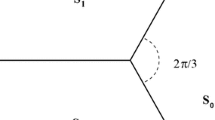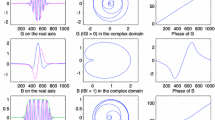Abstract
This paper proposes a new method of convergence acceleration of series expansion of complex functions which are analytic on and inside the unit circle in the complex plane. This class of complex functions may have some singularities outside the unit circle, which dominate convergence of series expansion. In the proposed method, the singular points are moved away from the origin using conformal mapping, and the function is expanded using a sequence of polynomials orthogonalized on the boundary of the mapped complex domain. The decay rate of coefficients of the orthogonal polynomial expansion can be related to the convergence region in a similar form to the Cauchy–Hadamard formula for power series. Using this relation, we quantitatively evaluate and maximize the convergence rate of the improved series. Numerical examples demonstrate that the proposed method is effective for slow convergent series, and may converge faster than Padé approximants.












Similar content being viewed by others
Notes
http://www-an.acs.i.kyoto-u.ac.jp/~fujiwara/exflib/. This URL was last accessed on December 27, 2013.
References
Baker, G.A., Graves-Morris, P.: Padé approximants, 2nd edn. Cambridge University Press, Cambridge (1996)
Bender, C.M., Orszag, S.A.: Advanced mathematical methods for scientists and engineers. McGraw-Hill, USA (1978)
Brezinski, C., Redivo Zaglia, M.: Extrapolation methods: theory and practice. North-Holland, Amsterdam (1991)
Hardy, G.H.: Divergent series, 2nd edn. AMS Chelsea Publishing, Providence (1991)
Henrici, P.: Applied and computational complex analysis, vol. 3. Wiley, New York (1986)
Higham, N.J.: Accuracy and stability of numerical algorithms, 2nd edn. SIAM, Philadelphia (2002)
Hille, E.: Analytic functions, vol. 2. AMS Chelsea Publishing, Providence (1962)
Hinch, E.J.: Perturbation methods. Cambridge University Press, Cambridge (1962)
Mori, M.: Analytic representations suitable for numerical computation of some special functions. Numer. Math. 35, 163–174 (1980)
Murashige, S.: Numerical use of exterior singularities for computation of gravity waves in shallow water. J. Eng. Math. 77, 1–18 (2012)
Murashige, S.: Davies’ surface condition and singularities of deep water waves. J. Eng. Math. 85, 19–34 (2014)
Sewell, W.E.: Degree of approximation by polynomials in the complex domain. In: Ann. Math. Stud. vol. 9. Princeton University Press, Princeton (1942)
Sidi, A.: Practical extrapolation methods. Cambridge University Press, Cambridge (2003)
Stahl, H., Totik, V.: General orthogonal polynomials. Cambridge University Press, Cambridge (1992)
Szegö, G.: Orthogonal polynomials, vol. 23, 4th edn. American Mathematical Society, Colloquium publications, Providence (1975)
Takahasi, H., Mori, M.: Analytic continuation of some special functions by variable transformation. Jpn. J. Appl. Math. 1, 337–346 (1984)
Tanaka, M.: The stability of steep gravity waves. J. Phys. Soc. Jpn. 52, 3047–3055 (1983)
Totik, V.: Orthogonal polynomials. Surv. Approx. Theory 1, 70–125 (2005)
Van Dyke, M.: Analysis and improvement of perturbation series. Q. J. Mech. Appl. Math. 27, 423–450 (1974)
Walsh, J.L.: Interpolation and approximation by rational functions in the complex domain, vol. 20, 5th edn. American Mathematical Society, Colloquium publications, Providence (1969)
Wu, T.Y., Kao, J., Zhang, J.E.: A unified intrinsic functional expansion theory for solitary waves. Acta Mech. Sin. 21, 1–15 (2005)
Author information
Authors and Affiliations
Corresponding author
Appendix. The proof of the contraction property (14) of the map \(F\) in Theorem 1
Appendix. The proof of the contraction property (14) of the map \(F\) in Theorem 1
The contraction property (14) of the map \(F\) in Theorem 1 can be proved as follows. First, for convenience, we write (12) as \(H_{\beta ^*}(\zeta ) = G_\mu (H_\beta (z))\) with \(H_{\beta ^*} :\zeta \mapsto \hat{z}\), \(H_\beta :z \mapsto \check{z}\) and \(G_\mu :\check{z} \mapsto \hat{z}\) defined by
Then the map \(F\) defined by (9) can be rewritten in the form
and the contraction property (14) can be expressed as
where \(D_z\) and \(D_\zeta \) are the unit disks \(|z| < 1\) in the \(z\)-plane and \(|\zeta | < 1\) in the \(\zeta \)-plane, respectively. Thus we can prove (14) by showing that
Using \(\hat{z} = r \mathrm {e}^{\mathrm {i}\theta }\), the boundary of \(G_{\mu }(H_{\beta }(D_z))\) in the \(\hat{z}\)-plane is given by
where \(B = (1 + \beta )/(1 - \beta ) > 1\). Similarly, noting that \((1+\beta ^{*})/(1-\beta ^{*}) = B^{\mu }\), we can represent the boundary of \(H_{\beta ^{*}}(D_\zeta )\) by
The domains \(G_{\mu }(H_{\beta }(D_z))\) and \(H_{\beta ^{*}}(D_\zeta )\) are both in the right half of the \(\hat{z}\)-plane and symmetric with respect to the real axis, as shown in Fig. 13. Thus it suffices to consider the region for \(0 \le \theta < \pi /2\) in the \(\hat{z}\)-plane. Equations (49) and (50) are quadratic with respect to \(r^{1/\mu }\) and \(r\), respectively, and the corresponding discriminants for \(r \ge 0\) and \(0 \le \theta < \pi /2\) produce the following conditions:
The mapped domains \(G_{\mu }(H_{\beta }(D_z))\) and \(H_{\beta ^{*}}(D_\zeta )\) in the \(\hat{z} ~ (=\hat{x} + \mathrm {i}\hat{y})\)-plane for \(\beta = 0.9\) and \(\mu = 0.4\). The solid and dashed closed curves represent the boundaries of \(G_{\mu }(H_{\beta }(D_z))\) and \(H_{\beta ^{*}}(D_\zeta )\), respectively. The maps \(H_{\beta }\), \(H_{\beta ^*}\) and \(G_\mu \) are defined in (45). \(D_z\) and \(D_\zeta \) denote the the unit disks \(|z| < 1\) in the \(z\)-plane and \(|\zeta | < 1\) in the \(\zeta \)-plane, respectively. The straight lines \(\mathrm {OP}\) and \(\mathrm {OQ}\) are in contact with \(G_{\mu }(H_{\beta }(D_z))\) at \(\mathrm {P}\) and \(H_{\beta ^{*}}(D_\zeta )\) at \(\mathrm {Q}\), respectively. The points \(\mathrm {P}_1\), \(\mathrm {P}_2\), \(\mathrm {Q}_1\) and \(\mathrm {Q}_2\) are on the same straight line. \(\theta _{\mathrm {P}} = \angle \,\mathrm {P}_0\mathrm {O}\mathrm {P}\), \(\theta _{\mathrm {Q}} = \angle \,\mathrm {P}_0\mathrm {O}\mathrm {Q}\), \(r_{\mathrm {P}_1} = \overline{\mathrm {OP}_1}\), \(r_{\mathrm {P}_2} = \overline{\mathrm {OP}_2}\), \(r_{\mathrm {Q}_1} = \overline{\mathrm {OQ}_1}\) and \(r_{\mathrm {Q}_2} = \overline{\mathrm {OQ}_2}\)
where \(\ell _B = \log B > 0\). For the cases of equality \(\sin (\theta /\mu ) = \tanh \ell _B\) and \(\sin \theta = \tanh (\mu \,\ell _B)\) in (51), we write \(\theta = \theta _{\mathrm {P}}\) and \(\theta = \theta _{\mathrm {Q}}\), respectively, namely
Also let \(r_{\mathrm {P}_1}(\theta )\) and \(r_{\mathrm {P}_2}(\theta )\) be the solutions of (49) with \(r_{\mathrm {P}_1}(\theta ) \le r_{\mathrm {P}_2}(\theta )\) for \(0\le \theta \le \theta _{\mathrm {P}}\), and let \(r_{\mathrm {Q}_1}(\theta )\) and \(r_{\mathrm {Q}_2}(\theta )\) be the solutions of (50) with \(r_{\mathrm {Q}_1}(\theta ) \le r_{\mathrm {Q}_2}(\theta )\) for \(0\le \theta \le \theta _{\mathrm {Q}}\), as shown in Fig. 13. We can show that \(\theta _{\mathrm {Q}}/\theta _{\mathrm {P}}\) is the monotone decreasing function with respect to \(\mu \), and that \(\mathrm {d}\log r_{\mathrm {Q}_1}/\mathrm {d}\theta \le \mathrm {d}\log r_{\mathrm {P}_1}/\mathrm {d}\theta \) and \(\mathrm {d}\log r_{\mathrm {P}_2}/\mathrm {d}\theta \le \mathrm {d}\log r_{\mathrm {Q}_2}/\mathrm {d}\theta \). From these, we get
and
These results indicate that (48) holds, and thus the contraction property (14) of the map \(F\) in Theorem 1 is proved.
About this article
Cite this article
Murashige, S., Tanaka, K. A new method of convergence acceleration of series expansion for analytic functions in the complex domain. Japan J. Indust. Appl. Math. 32, 95–117 (2015). https://doi.org/10.1007/s13160-014-0159-z
Received:
Revised:
Published:
Issue Date:
DOI: https://doi.org/10.1007/s13160-014-0159-z





